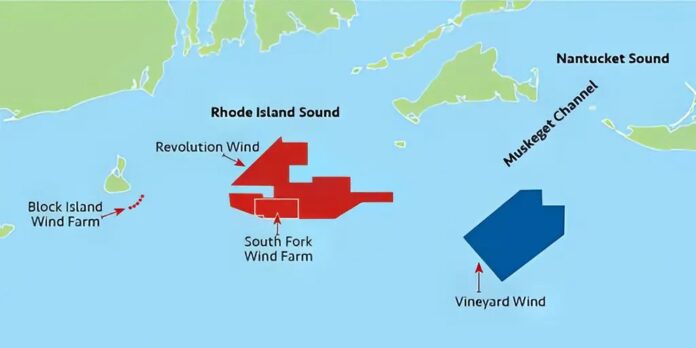By Allen Brooks
Ed. Note: The government-enabled on-grid wind and solar industries are on the downside of a political business cycle. The lesson for sustainable entrepreneurship is to meet underlying consumer demand, not rely on special favor from temporary political majorities.
Last Friday, the Daily Caller News Foundation broke an exclusive story that the U.S. had ordered a halt to construction on the offshore Revolution Wind Farm project. The article, “Trump Admin Kills Massive Offshore Wind Project,” announced the Bureau of Ocean Energy Management (Department of Interior.
Revolution Wind is a 704-megawatt (MW), 65-turbine wind project located 15 miles south of Rhode Island’s Point Judith port and 32 miles southwest of Martha’s Vineyard. The capacity has been contracted under 20-year power-purchase agreements to utilities in Massachusetts (304 MW) and Rhode Island (400 MW).
A second project (Revolution Wind 2) was rejected by Rhode Island Energy (PPL Corporation) and Rhode Island’s Public Utilities Commission and U.S. Department of Energy staff as too expensive.
The project is located on the federal lease area (OCS-A 0486), which developer Ørsted acquired when it purchased Deepwater Wind LLC, the developer of the Block Island Wind farm and holder of various offshore wind leases, in late 2018 for $510 million.
The locations of significant offshore wind projects.

Construction began on Revolution Wind in 2023, with the installation of the first offshore wind turbine in September 2024. Completion and operation of the project is scheduled in early 2026. Ørsted reported Friday night that the project was 80 percent complete with 45 of 65 wind turbines installed. The project was hailed as the first multi-state offshore wind project in the United States.
The DOI Director’s Order was issued by Matthew Giacona, Acting Director. Compare and contrast his letter with the one issued by Walter Cruickshank on April 16, 2025, ordering stoppage of Empire Wind.
DOI Letters: Empire State vs. Revolution Wind
In the Empire Wind stop-work order, the DOI cited as its reason to freeze work
to allow time for it to address feedback it has received, including from the National Oceanic and Atmospheric Administration (NOAA), about the environmental analyses for that project. BOEM received this and other feedback regarding Empire Wind as an outgrowth of the review that the Department is engaged in related to offshore wind projects.
In contrast, the Revolution Wind order stated:
… BOEM is seeking to address concerns related to the protection of national security interests of the United States and prevention of interference with reasonable uses of the exclusive economic zone, the high seas, and the territorial seas, as described in that subsection of OCSLA.
There are two relevant facts and one supposition.
Fact 1: The fact we know about the Empire Wind stop-work order is that, in response to a freedom of information request, the DOI released a 36-page study related to its stop-work decision. The report was titled “Screening Analysis: A Summary of the Record for the Empire Wind Project-NMFS Fisheries Resources.” Twenty-seven of the pages were entirely redacted, a privilege due to the deliberative nature of the report and its role in the review process underway at the time. The public has learned that government agencies are entitled to protect internal studies from public release until final reviews are completed.
Fact 2: With respect to the DOI stop-work order for Revolution Wind, the issue is compliance with Outer Continental Shelf Lands Act (OCSLA) provisions. Consulting firm PLANET A* STRATEGIES℠ studied the compliance of the Bureau of Ocean Energy Management (BOEM) with the provisions of the laws governing the use of our nation’s oceans. The report was titled, “Cancelling Offshore Wind Leases” with a subheading of “Outer Continental Shelf Lands Act Non-Compliance in Offshore Wind Plant Leasing and Permitting Programs.” Their report was completed in early May, and the findings were presented to the DOI.
Supposition: The supposition relates to the reported agreement between the Trump administration and New York Governor Kathy Hochul for her support in the issuance of previously blocked permits allowing the construction of two natural gas pipelines into the state. That would boost supply to both New York and New England, both of which are short of natural gas supply for generating electricity during the winter months when the gas is diverted to home heating. That shortage causes winter electricity prices in the region to be much higher than during the summer months.
Sunrise Wind Next?
At the time of the Empire Wind stop-work order in April, I predicted the summer would be an interesting period for offshore wind legal activity. So far, so true. Adding to the legal activity, a petition was recently sent to Interior Secretary Doug Burgum requesting a re-examination of the approval of Sunrise Wind, a 924 MW, 84-turbine project. It is located about 19 miles south of Martha’s Vineyard, 30 miles east of Montauk Point, Long Island, and 17 miles from Rhode Island’s Block Island. This is another Ørsted project.
The approval process for Sunrise Wind is being challenged by the former members of the Rhode Island Fishermen’s Advisory Board (FAB), established under legislation regulating the state’s Department of Environmental Management’s review and approval of offshore wind projects that impact the state’s waters.
The complaint demonstrates
… misapplication of section 8(p)(4) of OCSLA and misapplication of NEPA (National Environmental Protection Act), attest to the illegal impacts to the fishing industry that were ignored in permitting the project, attest to the environmental impacts that were ignored in permitting the project, and request that all approvals of the project be rescinded.
Looking Ahead
There is much to come with the above projects given the plight of Ørsted, which is trying to raise $9.4 billion of additional capital to support its ongoing developments.
Offshore wind developers are speaking out about violations of the legal approval process, which have and will continue to harm other legitimate users of the ocean shared with the wind project. As summer winds down, the legal battles over offshore wind are heating up.
Related
Discover more from Watts Up With That?
Subscribe to get the latest posts sent to your email.



